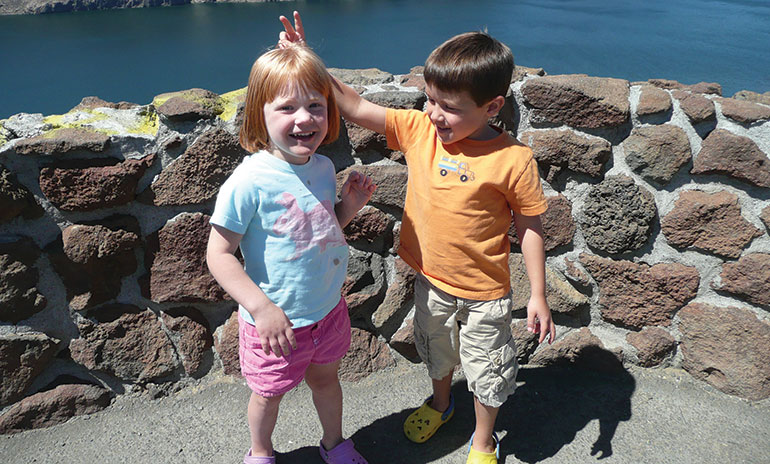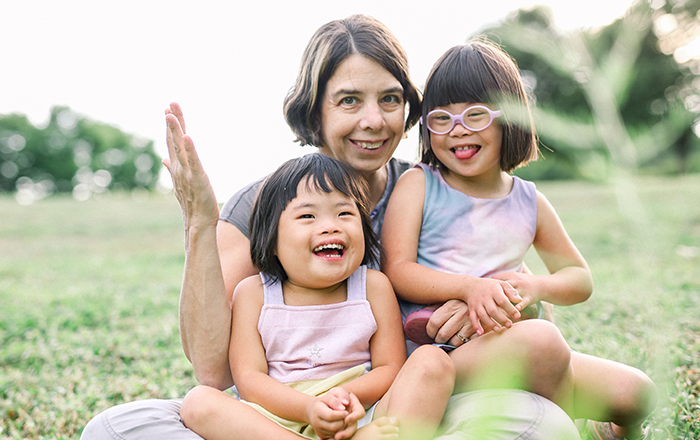Whether they are known or unknown, biological siblings are the rule, not the exception, for most adoptive families. A recent survey found that 71 percent of adopted children have known birth siblings, and the parents of another 14 percent couldn’t rule out the possibility.
“On some reunion registries, there are as many—and sometimes more—adopted people looking for their siblings than for their birth parents,” says Adam Pertman, executive director of the Evan B. Donaldson Adoption Institute. “That tells us something big, and we should be listening.”
Of course, finding sibs needn’t wait until children become adults. “Maintaining relationships among birth siblings is good practice,” Pertman says. In fact, more families are doing just that. How are these parents and children handling the searches, the meetings, and the accompanying conversations? Six families share their birth sibling stories with Adoptive Families.
Keeping Birth Siblings in the Picture
Kevin and Kiersa Durfee, of Arcadia, Florida, already had a biological son, Kaleb, when they began looking into adoption. The birth mother they were matched with, Danielle, was also raising a son—and she chose the Durfee family because she wanted the baby girl she was carrying to have an older brother.
Kaleb was the same age as Danielle’s son, Austin, and the boys were delighted to discover each other as the two families embarked on an open adoption. “I think Danielle was surprised that we were including her, and the beginning was a little tense,” Kevin reports of their early get-togethers.
Although those early tensions eased, contact decreased during the four years that followed as both families underwent life changes. Danielle gave birth to a second boy, Jesse, and decided to parent. The Durfees moved to a different state, but they’re working to keep Kyra’s birth siblings in the picture. She does so, literally, by displaying a photo of them in her room. The family also speaks of them often. “While she is too young to fully understand who they are, we want her to have lots of contact as they all grow up together,” says Kiersa.
For his part, seven-year-old Kaleb is “beginning to understand the complexities of the relationships,” says Kiersa. “He’s decided to call his sister’s birth siblings his ‘cousins’—it’s the best way he can sum up the relationship, and we encourage his ingenuity. We want our kids to think of this as an extended family, and that’s what they do!”
Change of Plans
“God laughs at those who plan” is an aphorism James and Norma Jean Davis-Brown understand well. The couple and their 10-year-old daughter, Jaylene, adopted domestically, had just moved into a three-bedroom townhouse in the Bronx, New York, when their well-laid plans went awry. “We had planned to turn the spare bedroom into a home office,” recalls Norma Jean. “Then we got the call.”
“The call” alerted the Browns that Jaylene’s birth mother had had another baby girl, and that they, as the family raising her birth sibling, had priority.
“I called James and said, ‘Hon, how fond are you of the idea of having that office?’” Norma Jean laughs. Jaylene was quick to get on board. “My husband asked her, ‘What’s the main thing you want more than anything?’ Jaylene said, ‘A brother.’ We said, ‘How about a sister?’ And she was like, ‘Yes! Yes!’ She was so excited, she did cartwheels.”
They brought their second daughter, Jayda, home this past March—and haven’t looked back. “The bottom line was, we couldn’t say no to Jayda, because she was a biological sibling,” Norma Jean says. Jaylene has embraced the role of big sis so enthusiastically that Norma Jean often has to remind her who’s mommy: “I didn’t realize how much it would mean to her. She’s very protective. The baby starts crying, and she runs to the nursery.”
Norma Jean says she and James were able to meet both birth parents once, and “I could see it was a very hard decision for them.” She’s continued to send letters and pictures, but the birth mother hasn’t picked them up for the last three or four years. Even so, the future is open. Jayda and Jaylene have two older siblings who live with their birth mom. Visits with them are in the cards, says Norma Jean, if all the parents agree.
For now, the new mom to two is “still in dream mode. It’s funny—Jayda definitely has a different personality, but, in some ways, it feels like I have the same baby again. I can’t help but love her.”
“I Have a Baby Sister”
Nathan Wright was just past his second birthday when he began telling his parents, with ironclad certainty, that he had a baby sister. Heather and Robert Wright had adopted Nathan a little over a year before, in Novosibirsk, Siberia, and he was their only child. So, except for the birth mother’s older daughter, back in Russia, there was no sister, and—nope, nyet—no baby sister.
Still, Nathan persisted. “Mama, I have a baby sister,” he regularly announced during dinners, diaperings, and car rides.
Then one day Nathan did have a baby sister. In June 2005 the Wrights received word from their agency that Nathan’s birth mother had relinquished a six-month-old girl, Nathan’s full biological sister. What’s more, this little girl had been born in December 2004—around the time Nathan began his pronouncements.
The mouths of babes? Heavenly intervention? Whatever the case, chalk this one up to the power birth siblings have upon us.
Today Nathan is seven, and his sister, Lauren, also adopted by the Wrights, is five. Lauren has no interest (as yet) in their birth mother; Nathan asks questions. “They are both dying to meet their older birth sister,” reports their mom. “They fight like cats and dogs, but they clearly have a deep connection and love for each other.”
One thing more, Wright adds: “Two years ago Nathan started telling us he had a brother.”
Not One But Two Birth Siblings!
For Jan Kelsay and her daughter, Josie, now 14, the information about siblings arrived during their visit to Josie’s orphanage in Vietnam. It turns out, she had not one but two birth siblings—twins!—who lived just hours away from the Kelsays’ Dallas home.
“We were thrilled,” Kelsay recalls. “It seemed like there was a chance we actually might be able to meet.”
Lucy Matte, the mom to twins Sam and Max, however, was hesitant. “It took me nearly a week to sit my boys down and talk about this.” They were just 12, after all, and had worries: “Are we all going to live together?” “Is she going to be our mom?”
Matte reassured her boys and, when the families finally met, they meshed. That first meeting was planned carefully. “We didn’t want it to be uncomfortable, with everybody just staring at each other,” says Matte of their decision to meet at a Six Flags near Dallas. She needn’t have worried. “All doubt was immediately erased. The three of them could pass as triplets!” says Kelsay. The moms, too, had much in common: Both were single, both worked in special-education, both were dealing with aging parents.
Says Sam, now 13, “I was amazed to know I had a sister and freaked out because I didn’t think it was possible.” The freak-outs have eased, he admits. Getting to know Josie has made him keen to visit Vietnam and look forward to meeting birth siblings and his birth parents.
Matte remembers her difficult decision to accept twins. It would be a financial strain, but her sons’ opportunity of “being with a sibling felt so right. Then, Josie and Jan came into the family picture.”
When Sibling Reunions Derail
In my own case, the street address of my daughter’s birth family, which includes four birth siblings, was in the documents I received in Russia. That information prompted a years-long dialogue that yielded revelations about two subsequent sisters, born after my Anya, and both adopted by American families. Today, my relationships with those two families couldn’t be more different.
Jennifer and Brad Condon, of Greenwood, Indiana—parents to Lily, seven—seemed pleased when I called. Today, we’re all friends on Facebook. We’ve exchanged Christmas cards. They’ve spoken of a trip to the East Coast and a potential meet-up.
The family of Olivia, 10, live less than two hours away from us—yet I don’t know where. I don’t even know their last name. The one time we met, the mother said she was glad to meet Anya and to receive the photos and letters I shared from the birth family, but she seemed tense, fragile. We’re not sure if she ever told Olivia about her birth sisters.
“She should know,” 14-year-old Anya says, “not only where she came from and that she was adopted, but that she has a family in Russia and two birth sisters in the U.S. As we all get older, we could connect with one another, and feel like more of a family.” I, too, look forward to meeting both girls and being able to call them my “nieces,” or any other future connection life can offer.



